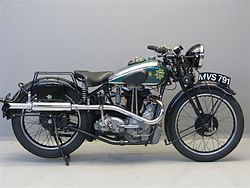BSA Empire Star
 | |
| Manufacturer | |
|---|---|
| Production | 1936-1939 |
| Engine | 249, 348 and 499cc single cylinder 4 stroke |
| Transmission | 4 Speed / chain |
Development
Developed from the popular BSA Blue Star and designed by Val Page, the Empire Star range had the benefit several ideas Page had been developing at his previous employers, Ariel and Triumph motorcycles. With a heavy frame and iron barrelled pushrod valves the Empire Star still had the legacy of the earlier BSA's however, and Page continiued to lighten it and introduce engine tuning ideas throughout production.The overhead valve Empire Star was available as the 250cc 'B22', the 350cc 'R5' and the 500cc 'Q8' models. Based on the standard BSA Blue Star the 'Empire' featured an alloy primary chaincase with a special high compression piston and a hardened cylinder bore. It also had some modern features, including a new foot-change gearbox and dry sump lubrication.
BSA launched the range of Empire Star models in 1936 with an effective demonstration of their reliability - a 500cc model was subjected to an endurance test of 500 miles at Brooklands, averaging speeds of over 70 mph round the oval track. This was followed by a 1000 mile endurance ride around the UK, visiting the West Country, Wales and the Lake District. The whole trip was completed successfully without the need for any spare parts - an important selling point for BSA in an increasingly competitive marketplace.
The outbreak of the second world war ended production of the Empire Star in 1939 as the BSA factory switched to making munitions and producing the BSA M20 for the British Army.
Racing success
It was the top of the range 496cc Empire Star, which saw most success in competition. In 1937 at Brooklands race track, Isle of Man TT winner Walter Handley won a race with a fastest lap at 107.57 mph on a specially modified 500cc Empire Star with a high compression piston and using alcohol as fuel. It also had a special racing carburettor, a new design of magneto and close ratio gearin. Handley had been persuaded out of 'retirement' especially for the three-lap race, which meant eight miles at top speed on the uneven and deteriorating banked oval track. It took skill and experience to win, and Handley was awarded one of the traditional Gold Star badges. This inspired BSA to develop the BSA Gold Star.
Also in 1937 BSA competition team rider Bert Perrigo won both the Colmore Cup and Victory Cup trials on a B25 Empire Star.










0 comments:
Post a Comment